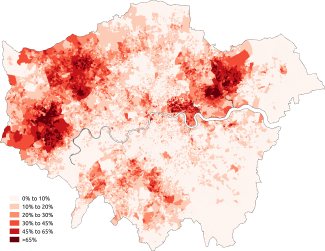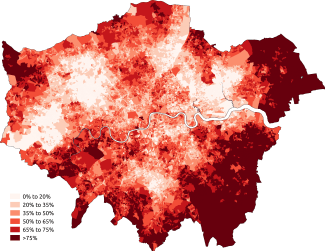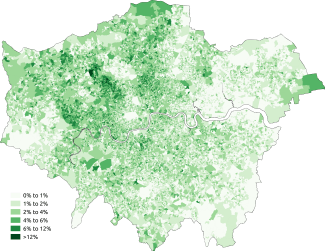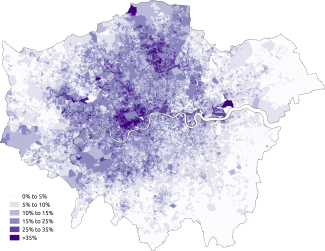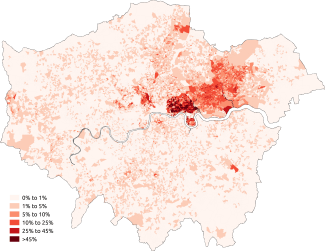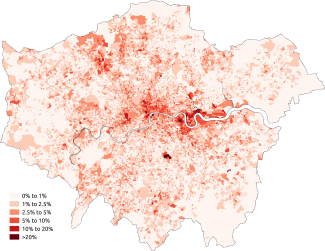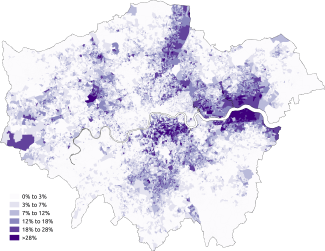Ethnic groups in London
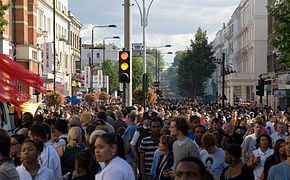
London is one of the most ethnically diverse cities on earth. In 2007 there were over 300 languages spoken in it and more than 50 non-indigenous communities with a population of more than 10,000.[1]
At the 2011 census London had a population of 8,173,941. Of this number, 44.9% were White British. 37% of the population were born outside the UK, including 24.5% born outside of Europe.[2]
Ethnic breakdown
2011 Census
| Number | Percentage of total population[3] | |
| White: English/Welsh/Scottish/Northern Irish/British | 3,669,284 | 44.9 |
| White: Irish | 175,974 | 2.2 |
| White: Gypsy or Irish Traveller | 8,196 | 0.1 |
| White: Other White | 1,033,981 | 12.6 |
| White: Total | 4,887,435 | 59.8 |
| Mixed/multiple ethnic group: White and Black Caribbean | 119,425 | 1.5 |
| Mixed/multiple ethnic group: White and Black African | 65,479 | 0.8 |
| Mixed/multiple ethnic group: White and Asian | 101,500 | 1.2 |
| Mixed/multiple ethnic group: Other Mixed | 118,875 | 1.5 |
| Mixed/multiple ethnic group: Total | 405,279 | 5.0 |
| Asian/Asian British: Indian | 542,857 | 6.6 |
| Asian/Asian British: Pakistani | 223,797 | 2.7 |
| Asian/Asian British: Bangladeshi | 222,127 | 2.7 |
| Asian/Asian British: Chinese | 124,250 | 1.5 |
| Asian/Asian British: Other Asian | 398,515 | 4.9 |
| Asian/Asian British: Total | 1,511,546 | 18.4 |
| Black/African/Caribbean/Black British: African | 573,931 | 7.0 |
| Black/African/Caribbean/Black British: Caribbean | 344,597 | 4.2 |
| Black/African/Caribbean/Black British: Other Black | 170,112 | 2.1 |
| Black/African/Caribbean/Black British: Total | 1,088,640 | 13.3 |
| Other ethnic group: Arab | 106,020 | 1.3 |
| Other ethnic group: Any other ethnic group | 175,021 | 2.1 |
| Other ethnic group: Total | 281,041 | 3.4 |
| Total | 8,173,941 | 100 |
| Distribution of ethnic groups in Greater London according to the 2011 census. | ||||||||||||||||||||||||||
|---|---|---|---|---|---|---|---|---|---|---|---|---|---|---|---|---|---|---|---|---|---|---|---|---|---|---|
|
Black Population of London
At the 2011 census, the total Black population of London stood at 1,088,640.[4] This is a rise of 39% from the 2001 census, when the population stood at 781,751.
Inner London and Outer London have a near-equal black population. The 2011 census is the first time that the black population in Outer London has overtaken that of Inner London:
| Black African Population | Black Caribbean Population | Other Black Population | Total Black Population | |
|---|---|---|---|---|
| Inner London | 276,513 | 173,959 | 89,709 | 540,181 |
| Outer London | 297,418 | 170,638 | 80,403 | 548,459 |
| London | 573,931 | 344,597 | 170,112 | 1,088,640 |
The black population of London is mainly concentrated in the South London area. Southwark has the highest Black African population, Croydon has the highest Black Caribbean population and Lambeth has the highest total black population in London. The twenty London boroughs with the highest total Black population (Black African, Black Caribbean and Other Black) are listed below:
| Rank | London Borough | Black African Population | Black Caribbean Population | Other Black Population | Total Black Population |
|---|---|---|---|---|---|
| 1 | Lambeth | 35,187 | 28,886 | 14,469 | 78,542 |
| 2 | Southwark | 47,413 | 17,974 | 12,124 | 77,511 |
| 3 | Lewisham | 32,025 | 30,854 | 12,063 | 74,942 |
| 4 | Croydon | 28,981 | 31,320 | 12,955 | 73,256 |
| 5 | Newham | 37,811 | 15,050 | 7,395 | 60,256 |
| 6 | Brent | 24,391 | 23,723 | 10,518 | 58,632 |
| 7 | Hackney | 27,976 | 19,168 | 9,714 | 56,858 |
| 8 | Enfield | 28,222 | 17,334 | 8,131 | 53,687 |
| 9 | Greenwich | 35,164 | 8,051 | 5,440 | 48,655 |
| 10 | Haringey | 23,037 | 18,087 | 6,706 | 47,830 |
| 11 | Waltham Forest | 18,815 | 18,841 | 7,135 | 44,791 |
| 12 | Barking and Dagenham | 28,685 | 5,227 | 3,228 | 37,140 |
| 13 | Ealing | 17,299 | 13,192 | 6,369 | 36,860 |
| 14 | Barnet | 19,392 | 4,468 | 3,571 | 27,431 |
| 15 | Islington | 12,622 | 7,943 | 5,729 | 26,294 |
| 16 | Redbridge | 12,357 | 9,064 | 3,424 | 24,845 |
| 17 | Hammersmith and Fulham | 10,552 | 7,111 | 3,842 | 21,505 |
| 18 | Merton | 10,442 | 8,126 | 2,243 | 20,811 |
| 19 | Hillingdon | 11,275 | 4,615 | 4,192 | 20,082 |
| 20 | Harrow | 8,526 | 6,812 | 4,370 | 19,708 |
Asian Population of London
At the 2011 census, the total Asian population of London stood at 1,511,546.[4] This is a rise of 60% from the 2001 census, when the population stood at 947,425.
Outer London has a greater Asian population than Inner London:
| Indian Population | Pakistani Population | Bangladeshi Population | Chinese Population | Other Asian Population | Total Asian Population | |
|---|---|---|---|---|---|---|
| Inner London | 109,933 | 59,890 | 163,838 | 65,983 | 115,549 | 515,193 |
| Outer London | 432,924 | 163,907 | 58,289 | 58,267 | 282,966 | 996,353 |
| London | 542,857 | 223,797 | 222,127 | 124,250 | 398,515 | 1,511,546 |
The Asian population of London is concentrated across the city. Harrow has the highest Indian population, Redbridge has the highest Pakistani population and Tower Hamlets has the highest Bangladeshi and Chinese population. Newham has the highest total Asian population in London. The twenty London boroughs with the highest total Asian population (Indian, Pakistani, Bangladeshi, Chinese and Other Asian) are listed below.
| Rank | London Borough | Indian Population | Pakistani Population | Bangladeshi Population | Chinese Population | Other Asian Population | Total Asian Population |
|---|---|---|---|---|---|---|---|
| 1 | Newham | 42,484 | 30,307 | 37,262 | 3,930 | 19,912 | 133,895 |
| 2 | Redbridge | 45,660 | 31,051 | 16,011 | 3,000 | 20,781 | 116,503 |
| 3 | Brent | 58,017 | 14,381 | 1,749 | 3,250 | 28,589 | 105,986 |
| 4 | Tower Hamlets | 6,787 | 2,442 | 81,377 | 8,109 | 5,786 | 104,501 |
| 5 | Harrow | 63,051 | 7,797 | 1,378 | 2,629 | 26,953 | 101,808 |
| 6 | Ealing | 48,240 | 14,711 | 1,786 | 4,132 | 31,570 | 100,439 |
| 7 | Hounslow | 48,161 | 13,676 | 2,189 | 2,405 | 20,826 | 87,257 |
| 8 | Hillingdon | 36,795 | 9,200 | 2,639 | 2,889 | 17,730 | 69,253 |
| 9 | Haringey | 36,795 | 9,200 | 2,639 | 2,889 | 17,730 | 69,253 |
| 10 | Barnet | 27,920 | 5,344 | 2,215 | 8,259 | 22,180 | 65,918 |
| 11 | Croydon | 24,660 | 10,865 | 2,570 | 3,925 | 17,607 | 59,627 |
| 12 | Waltham Forest | 9,134 | 26,347 | 4,632 | 2,579 | 11,697 | 54,389 |
| 13 | Merton | 8,106 | 7,337 | 2,216 | 2,618 | 15,866 | 36,143 |
| 14 | Camden | 6,083 | 1,489 | 12,503 | 6,493 | 8,878 | 35,446 |
| 15 | Enfield | 11,648 | 2,594 | 5,599 | 2,588 | 12,464 | 34,893 |
| 16 | Wandsworth | 8,642 | 9,718 | 1,493 | 3,715 | 9,770 | 33,338 |
| 17 | Westminster | 7,213 | 2,328 | 6,299 | 5,917 | 10,105 | 31,862 |
| 18 | Greenwich | 7,836 | 2,594 | 1,645 | 5,061 | 12,758 | 29,894 |
| 19 | Barking and Dagenham | 7,436 | 8,007 | 7,701 | 1,315 | 5,135 | 29,594 |
| 20 | Southwark | 5,819 | 1,623 | 3,912 | 8,074 | 7,764 | 27,192 |
Foreign Born Population
At the 2011 census, 36.7% of London's population was foreign born (including 24.5% born outside of Europe).[5] With 2,998,264 residents born abroad, London has the second highest foreign-born population of any city in the world.
| Population born in the UK | Population Foreign-Born | |
|---|---|---|
| Inner London | 1,867,723 | 1,364,178 |
| Outer London | 3,307,954 | 1,634,086 |
| London | 5,175,677 | 2,998,264 |
| % born in the UK | % Foreign-Born | |
|---|---|---|
| Inner London | 57.8 | 42.2 |
| Outer London | 66.9 | 33.1 |
| London | 63.3 | 36.7 |
Significant ethnic minority communities
Bangladeshis
A major wave of immigration began in the 1970s, as people from the Sylhet Division arrived in London, fleeing poverty and the Bangladesh Liberation War. Many settled around Brick Lane, where they entered the textile trade. This trade has declined causing unemployment, but the community has moved into other businesses, including restaurants and banking. The level of immigration peaked in 1986 and has since entered a decline with the introduction of harsher immigration laws.
The community remains concentrated around Bethnal Green and Whitechapel and has spread into other east London boroughs. London as a city is home to the single largest number of people of Bangladeshi origin outside of Bangladesh, with close to 200,000 individuals being of full Bangladeshi origin in 2007.
Chinese
Chinese people constitute the fourth largest Asian group in London (behind the Indians, Pakistanis and Bangladeshis respectively); numbering 114,800 in 2007, they are spread more or less across the entire city and have become successful in British life, especially when it comes to cuisine. The history of the Chinese in London is long and complex, with the first Chinese people arriving in the city in the 19th century as sailors.
Ghanaians
Besides Nigerians, Ghanaians are one of the largest Black African groups in London, with the majority living in the boroughs of Southwark, Lambeth, Newham, Hackney, Haringey, Lewisham, Merton, Croydon, Enfield and Brent.[6]
Greeks
According to the "History of London's Greek community" by Jonathan Harris,[7] the Greek population of London numbered several thousand by 1870 AD whereas in 1850 AD it was just a few hundred. The 2001 Census recorded 12,360 Greek-born people living in London, with particular concentrations in the Hyde Park, Regent's Park, Chelsea and Kensington Census tracts.[8]
The Census tracts with the highest number of Cypriot-born people in 2001 were Palmers Green, Upper Edmonton, Cockfosters, Lower Edmonton, Tottenham North and Tottenham South.[9] Many Greek-Cypriots reside in Wood Green, Harringay and Palmers Green, the latter harbouring the largest community of Greek-Cypriots outside Cyprus, resulting in these areas bearing local nicknames whereby the Green is replaced by Greek – as in Greek Lanes and Palmers Greek.[10][11][12]
According to a City of London Corporation sponsored report,[13] there are between 280,600 and 310,000 Greek speakers in Greater London.
Indians
British Indians have long been one of London's largest ethnic minority groups and in 2007 over 500,000 Indians were residing in London (this excludes people of half or less Indian origin). Around 7% of London's population is of Indian origin. Indians have been in the British capital for generations and come from all walks of life.
Irish
Irish migration to Great Britain has a lengthy history due to the close proximity of, and complex relationship between, the islands of Ireland and Great Britain and the various political entities that have ruled them. Today, millions of residents of Great Britain are either from the island of Ireland or have Irish ancestry. Around six million Britons have an Irish grandfather or grandmother (approximately 10% of the UK population).[14] 900,000 ethnic Irish people live in the capital (12% of the city's population); despite this, some sources put the population of people of Irish descent in London at 77% (some five and a half million people), although the White British and White Irish populations combined are less than this.[15][16]
Although such claims are often exaggerated and the Irish coming to Britain were not all purely Gaelic in heritage many had mixed Irish and British or purely British origins. There is also the case historically of many Brits moving to Ireland and moving back to Britain; but as their families had lived in Ireland for many generations saw themselves as Irish and called themselves as such. Many Protestant Irish had also moved to Britain. It also doesn't take into account of millions of English leaving London for Ireland and other countries. Yet only 2.2% claim white Irish ethnicity so it seems many choose a white British ethnicity
Jamaicans
There are records that show Black people, predominantly from Jamaica, living in London during the 17th and 18th centuries; but it was not until the arrival of the Empire Windrush, on 22 June 1948, that significant numbers of Caribbeans, in particular Jamaicans, arrived in the capital. This has since become an important landmark in the history of modern multicultural Britain. During the post World War II era, the presence of these immigrants was requested to help reconstruct the British economy. Employers such as British Rail, the NHS and London transport recruited almost exclusively from Jamaica. Some 250,000 Londoners are of Jamaican origin.[17]
Japanese
Junko Sakai, author of Japanese Bankers in the City of London: Language, Culture and Identity in the Japanese Diaspora, stated that there is no particular location for the Japanese community in London, but that the families of Japanese "company men" have a tendency of living in North London and West London. Japanese restaurants and shops are located around these groups of Japanese people.[18]
Nigerians
London (in particular the southern boroughs) is home to the largest Nigerian community in the UK, and possibly the largest overseas Nigerian community in the world. The first Nigerians in London were those caught up in the slave trade over 200 years ago.
In the mid-20th century a wave of Nigerian immigrants came to London after hearing of the need for more skilled workers. Civil and political unrest in the country contributed to numerous refugees arriving in England.[19] The vast majority of famous and notable British people of Nigerian origin were either born in or now live in London.
Peckham (also known as Little Lagos and Yorubatown) is home to one of the largest overseas Nigerian communities in the world; many of the local establishments are Yoruba-owned. Nigerian churches and mosques can be found in the area. As immigrants become assimilated, English is becoming the predominant language of the local Nigerian British population. The Yoruba language is declining in use in the Peckham area despite the increasing Nigerian population.[20] In 2001, about 7% of Peckham's population was born in Nigeria.[21] A much larger proportion of the ward's 60% Black population is of Nigerian descent, as 40% are of other African descent.[22]
Pakistanis
Pakistanis in London form the largest concentrated community of British Pakistanis; immigration from regions which now form Pakistan predate Pakistan's independence.[23] The main concentrations of Pakistani settlement in London are found in Outer London with the boroughs of Redbridge, Newham and Waltham Forest accounting for nearly a third of Londoners of Pakistani Descent.
Turkish
Gallery
-
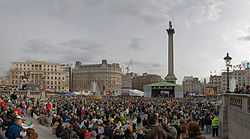
London's Irish community celebrating Saint Patrick's Day.
-
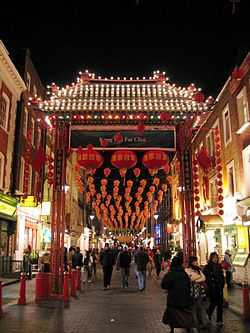
Chinatown, London during Chinese new year.
-

London Turks protesting.
-

London Bangladeshis at Baishakhi Mela.
-
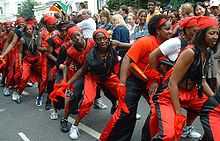
Kittitian and Nevisian street dancers at the Notting Hill Carnival.
-

London Iraqis celebrating 2007 AFC Asian Cup victory for Iraq.
-

Large numbers of Colombians live in London.
References
- ↑ Benedictus, Leo (2005-01-21). "Almost every race, colour, nation and religion on earth". London: Guardian. Retrieved 2010-01-03.
- ↑ http://www.ft.com/cms/s/0/4bd95562-4379-11e2-a48c-00144feabdc0.html#axzz2EmHkrZcr
- ↑ "2011 Census: Ethnic group, local authorities in England and Wales". Office for National Statistics. 11 December 2012. Retrieved 27 April 2015.
- ↑ 4.0 4.1 "Ethnic Groups in London". Census Update (Office for National Statistics) 2011: page 1. 11 December 2012. Retrieved 12 December 2011.
- ↑ "A summary of countries of birth in London". Census Update (Office for National Statistics) 2011: page 1. 11 December 2012. Retrieved 12 December 2011.
- ↑ Ghanaian London. Books.google.co.uk. 2008. ISBN 978-0-7546-4841-3. Retrieved 2010-01-03.
- ↑
- ↑ "Born abroad: Greece". BBC. 2005-09-07. Retrieved 2008-12-07.
- ↑ "Born abroad: Cyprus". BBC. 2005-09-07. Retrieved 2008-12-07.
- ↑ "Things you didn't know about... Palmers Green", Yellow Pages
- ↑ "Greek in Palmers Green", UKTV
- ↑ "Palmers Green", Trusted Places
- ↑ Philip Baker & John Eversley, Multilingual Capital, commissioned by City of London Corporation, published by Battlebridge 2000.
- ↑ Bowcott, Owen (2006-09-13). "''Six million Britons are entitled to Irish citizenship''". London: Guardian. Retrieved 2010-01-03.
- ↑ "Irish in London". Merseyreporter.com. Retrieved 2010-01-03.
- ↑ "Irish in London 2". BBC News. 2001-03-16. Retrieved 2010-01-03.
- ↑ "Jamaica Mapping Exercise" (PDF). International Organization for Migration. Retrieved 2010-04-22.
- ↑ Sakai, Page unstated (PT67). "Although the Japanese have no precise geographical location for their community, they are connected with each other personally, and one of their geographical centres is the Japanese school in London, previously in North London and now in West Acton."
- ↑ Nigerian London (2008-08-20). "Nigerian London". Bbc.co.uk. Retrieved 2010-01-03.
- ↑ "http://news.bbc.co.uk/1/hi/world/africa/4182341.stm". BBC News. 2005-01-25. Retrieved 2010-01-03.
- ↑ "UK statistics on Nigerian-born people in Britain". BBC News. 2005-09-07. Retrieved 2010-01-03.
- ↑ Neighbourhood Statistics. "Pecham Ethnicity, 2001". Neighbourhood.statistics.gov.uk. Retrieved 2010-01-03.
- ↑ "Pakistani London". BBC. 2005-05-26. Retrieved 2013-09-18.
Further reading
- Cherti, Miriam. Paradoxes of Social Capital: A Multi-generational Study of Moroccans in London (IMISCOE dissertations Sussex theses ; S 6271). Amsterdam University Press, 2008. ISBN 9053560327, 9789053560327.
External links
- Ethnicity Profiles: London by the Commission for Racial Equality

